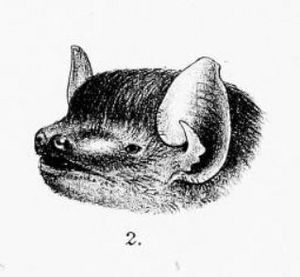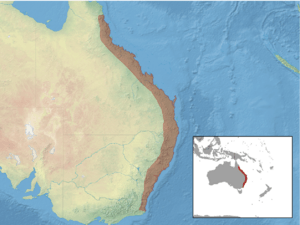Rüppell's broad-nosed bat facts for kids
Quick facts for kids Rüppell's broad-nosed bat |
|
|---|---|
 |
|
| Conservation status | |
| Scientific classification | |
| Genus: |
Scoteanax
|
| Species: |
rueppellii
|
 |
|
| Synonyms | |
|
|
The Rüppell's broad-nosed bat (Scoteanax rueppellii) is a type of small bat. It is also called the greater broad-nosed bat. This bat lives in eastern Australia. It belongs to a family of bats called vespertilionids.
Contents
About This Bat's Name
This bat was first described in 1866 by a German scientist named Wilhelm Peters. He gave it the name Nycticejus rüppellii. The bat's scientific name, "rueppellii", honors Eduard Rüppell. He was a scientist from the Frankfurt Museum who lent the bat specimen to Peters.
Later, in 1944, a scientist named Ellis Troughton placed this bat in its own special group, or genus, called Scoteanax. So, Scoteanax rueppellii is the only species in this group. People sometimes call it the 'broad-nosed bat'. But this name can also refer to other bats in a group called Scotorepens.
What Rüppell's Bat Looks Like
The Rüppell's broad-nosed bat is a medium-sized bat. It has a strong body. Its ears are short and set far apart on its head. If you were to press them together, they would barely touch. Each ear has a curved shape below its rounded tip.
Here are some average measurements for this bat:
- Its forearm is about 51 to 56 millimeters long.
- Its head and body together are about 63 to 73 millimeters long.
- Its tail is about 44 to 58 millimeters long.
- It weighs between 21 and 35 grams, with an average of 30 grams.
The fur on its back can be dark cinnamon or a medium brown color. Its belly fur is lighter, often a pale yellowish-brown. The skin that forms its wings, called the patagium, is a pinkish-brown color. Its face and ears do not have hair. A special feature of its teeth is that it has only one pair of incisors (front teeth) in its upper jaw, right next to its canine teeth.
How Rüppell's Bat Lives
During the day, these bats rest in tree hollows. They have also been found resting in roofs of buildings in cities. Scientists don't know a lot about the daily life and habits of Scoteanax rueppellii.
This bat eats insects. It flies slowly near streams or the edges of forests to hunt for larger insects, like flying beetles. It also eats smaller bugs. It moves slowly and is not very quick when chasing its prey. These bats are also known to eat other bats. This was first seen when bats in captivity ate other bats. Rüppell's broad-nosed bats usually have one baby in January.
Where Rüppell's Bat Lives
This bat is not very common. It lives along the eastern coast of Australia. In the north, it can be found at the Mount Carbine Tableland. From there, its home range stretches south along the coast. In the southern part of its range, in New South Wales, it prefers to live below 500 meters in height. However, in the northern tableland areas, it is only found at higher elevations.
Scientists are still trying to understand exactly where these bats live. A study in 2006 looked at past records. It found that the idea that these bats only live in certain altitudes or climates, or only in very thick forests, might not be true. More research is needed to confirm where S. rueppellii truly lives. This bat often lives in wet valleys in inland forests. But it is usually found in areas near the coast that get a lot of rain and have tall forests.
Protecting Rüppell's Bat
As of 2008, the IUCN says this bat is a least-concern species. This means it is not in immediate danger of disappearing. It has a large area where it lives, and its population is probably big. Scientists don't think its population is dropping quickly. However, its numbers are currently decreasing.
See also
 In Spanish: Scoteanax rueppellii para niños
In Spanish: Scoteanax rueppellii para niños


